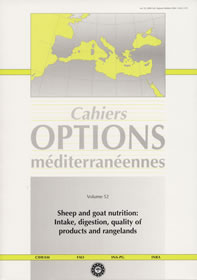| Article précédent | p. 119-124 | Article suivant |
Effect of rearing system on the growth rate and meat quality of young goats
Two groups of 12 male Alpine goat kids were raised from birth to slaughter either single suckling their dams (group N, natural) or artificially reared with a whey-based milk replacer from an automatic self-feeder (group A, artificial). Kids were slaughtered in two batches when they reached a weight of 12.5-15.5 kg, at 39 (N) and 43 (A) days of age. The cold carcass weights were 7.01 and 6.75 kg respectively. There were no significant differences in the carcass and L. thoracis muscle dimensions, kidney fat or flank colour between groups. In contrast, meat colour differed: L 48.8 vs 53.0, P less than 0.01; bstar 4.7 vs 6.2, P less than 0.05, in N and A respectively. The percentage of separable kidney fat and ether extract in the meat were slightly, but not significantly, higher in group A. The consumer acceptance of the meat from both groups, was good, with a slight preference for the product from the naturally suckled kids.
- [ Afficher ]
- [ Télécharger ]
- [ Exporter la citation ]
Vous pouvez télécharger la citation au format :
- [ Imprimer ]
-
Mots-clés
CAPRIN, CARCASSE, METHODE D'ELEVAGE, QUALITE, VIANDECiter cet article
Piasentier E., Mills C.R., Sepulcri A., Valusso R. Effect of rearing system on the growth rate and meat quality of young goats. In : Ledin I. (ed.), Morand-Fehr P. (ed.). Sheep and goat nutrition: Intake, digestion, quality of products and rangelands. Zaragoza : CIHEAM, 2000. p. 119-124. (Cahiers Options Méditerranéennes; n. 52). 8. Seminar of the Sub-Network on Nutrition of the FAO-CIHEAM Inter-Regional Cooperative Research and Development Network on Sheep and Goats, 1998/09/03-05, Grignon (France). http://om.ciheam.org/om/pdf/c52/00600321.pdf



